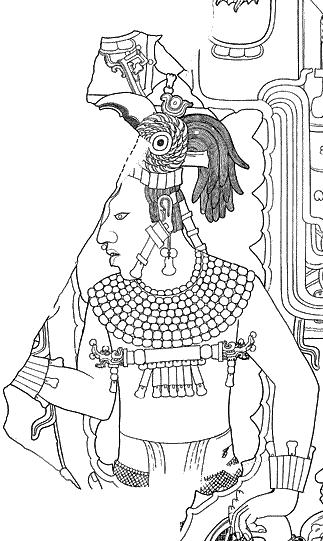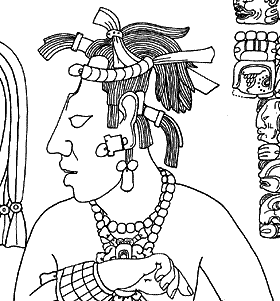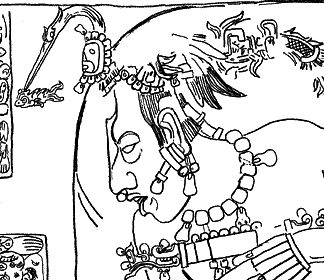
| Palenque ruler K'inich Ahkal Mo' Nahb' III, from the recently discovered Temple XIX hieroglyphic platform. |

![]()
Alfonso Morales
Principal Investigator, Palenque Project
|
With the latest excavations directed by the Group of the Cross Project, the PARI/INAH archaeological team in Palenque, Chiapas, Mexico, more information has come to light about one of the most important rulers of the later kingdom, K'inich Ahkal Mo' Nab' III.
Ahkal Mo' Nab' was born in 678 A.D., during the reign of Palenque's long-lived ruler K'inich Hanab Pakal. Often referred to as Pakal the Great, this ruler righted a kingdom that had been unstabilized by enemy attacks and oversaw a building program that culminated in the Temple of the Inscriptions, his own death memorial. His son, K'inich Kan Balam II (formerly known as Chan Bahlum), constructed the magnificent temples of the Cross Group. Between them they left a wealth of inscriptions detailing Palenque history. Ahkal Mo' Nab' became ruler in 721 at another time of great turmoil in the Palenque kingdom. Yet his construction program rivaled that of his illustrious predecessors, and in the newly discovered inscriptions of Temple XIX he has contributed enormously to the surviving records of Palenque history. The buildings associated with Ahkal Mo' Nab' are Group IV, Temple XVIII, Temple XXI, and Temple XVI. Now we know that Temple XIX must be added to this list. |

| K'inich Ahkal Mo' Nab' III from the Temple XIX limestone tablet. View entire tablet. (Drawing by Mark Van Stone.) |
|
Until his name glyphs were re-deciphered by Project epigrapher David Stuart (PARI Newsletter #28), K'inich Ahkal Mo' Nab' III was known as Akul Anab III and, before that, Chaacal III. (The honorific prefix k'inich became an actual part of the name of every Palenque ruler after K'inich Hanab Pakal.)
The known dates from his life include a pre-accession event that occurred in 719. The forty-year annniversary of this occasion is recorded in the new inscriptions of Temple XIX. We do not know when Ahkal Mo' Nab' died, but it is clear that he associated his name with an impressive number of monuments during his lifetime. |

| The central figure on the Tablet of the Slaves is now thought to represent K'inich Ahkal Mo' Nab' III. View Tablet of the Slaves. (Drawing by Merle Greene Robertson.) |
|
The monuments naming Ahkal Mo' Nab' are the Tablet of the Slaves, the stone jambs and stucco hieroglyphic text of Temple XVIII, a painted text in the Palace (House E, above the Oval Palace Tablet), the Tablet of the 96 Hieroglyphs, the K'an Tok' Tablet, a partial tablet from Temple XVI (currently on display at the big Maya exhibition in Mexico City), The Scribe, the Orator, and the alfarda tablets from Temple XXI. Now we have to include the new finds in Temple XIX: the stone throne, a stone panel and a stucco figure from the central pier.
The rulership of Ahkal Mo' Nab' comes ten years after the capture of K'inich K'an Hoy Chitam II, the second son of Pakal the Great, by the neighboring polity of Tonina. We know that Palenque's ruler was captured by the enemy because he is shown on a Tonina monument bound like a prisoner. But we do not know his exact fate. Was he tortured and sacrificed immediately, or was he allowed to live on in captivity for as long as a decade in order to disrupt the Palenque rulership? There is precedent in Classic Maya history for both sequences of events. The capture of K'an Hoy Chitam was clearly a shock to Palenque's dynasty, and the ten-year period between the capture and the accession of Ahkal Mo' Nab' III has been referred to by Peter Mathews as Palenque's "midlife crisis". It would seem that Palenque not only survived this crisis but, under the rulership of Ahkal Mo' Nab', regained, at least for a time, former glories. Architecturally, Temple XIX was the most ambitious structure ever built at Palenque. Its frontage is the longest of any building at the site. The lineage text of the Tablet of the 96 Hieroglyphs, commissioned by the late Palenque ruler K'inich K'uk' Balam II, makes no reference to a ruler during the ten years after K'an Hoy Chitam's capture. But, interestingly, it also fails to mention the known ruler Kan Balam II, Hanab Pakal's eldest son. It is my suggestion that perhaps K'uk' Balam II was only giving a list of his direct ancestors. The Tablet of the 96 Hieroglyphs is the last known stone inscription from Palenque. A period of almost fifty years separates it from the Temple XIX throne. Both display a masterful technique of incised carving, as distinct from the relief sculpture of other Palenque monuments in stone. |

| K'inich Ahkal Mo' Nab' III from the Temple XIX throne. Drawing by Merle Greene Robertson.. (Preliminary pencil drawing by Merle Greene Robertson.) |
|
Temples XIX and XXI are different from the traditional pattern of construction followed in Temple XVIII and the previous structures of Palenque. Temple XXI is built with larger cut stones, and the mortar is composed of a yellow clay. The stucco is only applied in the spaces between the stones. An innovation to the construction technique is a molding at floor level that keeps water from dripping directly into the substructure.
Temple XIX had stucco covering the wall and piers, but as in Temple XXI, instead of the traditional stucco, the floor was made of large stone slabs. The piers of this structure were built inside in the middle wall instead of in the front. The front had the largest doorway in Palenque. The second tier steps were modified to create two alfardas at their ends. I am speculating that the Scribe and Orator carvings were originally placed on these alfardas by Ahkal Mo' Nab' III and on a later date were moved to the Palace by his son K'uk' Balam II to flank the Tablet of the 96 Hieroglyphs, which was placed in the first of three steps in front of the Tower. We believe that the change of construction technique from the time of K'inich Hanab Pakal and Kan Balam II, when pure stucco was used as a mortar, and then during the reign of K'an Hoy Chitam, when the mortar was about ninety percent clay and the rest stucco, was because of the lack of trees to burn the lime to make stucco. We are taking soil samples from the top of the floors to analyze the types of tree pollen in an attempt to verify the theory of the depletion of trees in the area. With all the new information we need to re-analyze the rulership of K'inich Ahkal Mo' Nab' III, who seems to be one of the most important rulers in the late days of Palenque. |